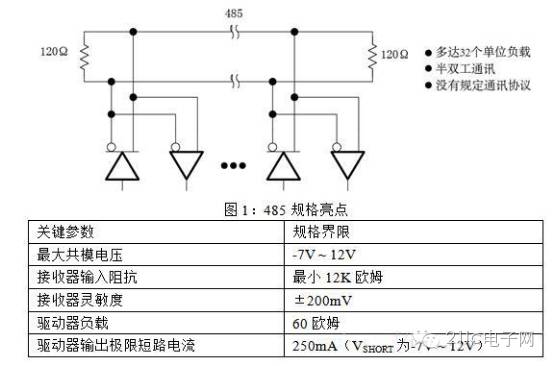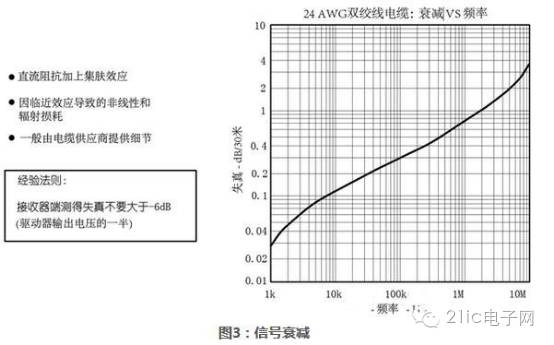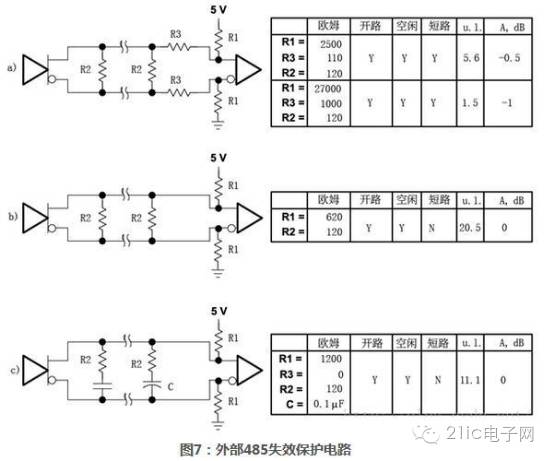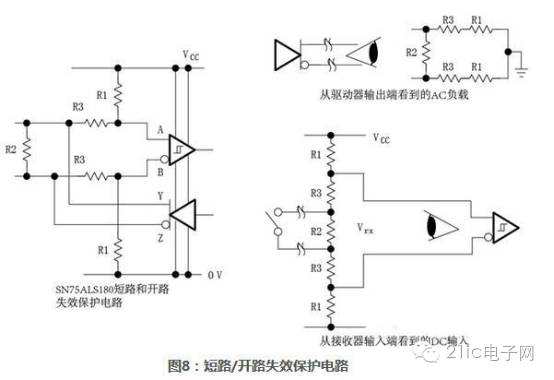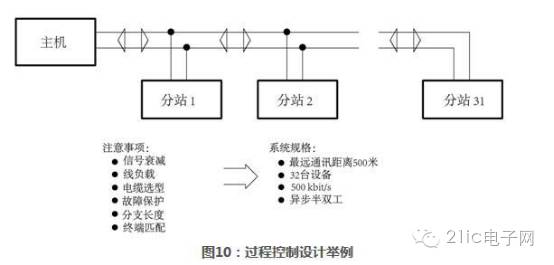
This design guide discusses how to design RS-485 interface circuits. The necessity of balanced transmission line standards is discussed, along with an example of process control design. The article also covers line load, signal attenuation, failure protection, and current isolation under different headings.
1. Why Balanced Transmission Line Standards Are Needed
This article focuses on the most widely used balanced transmission line standard in industry: ANSI/TIA/EIA-485-A (hereinafter referred to as 485). After reviewing some key aspects of the 485 standard, it introduces how to implement differential transmission structures in practical projects through an example of factory automation.
Data transmission between computer components and peripherals is often difficult in long-distance, high-noise environments, and if possible, single-ended drivers and receivers should be used. For systems requiring long-distance communication, a balanced digital voltage interface is recommended.
485 is a balanced (differential) digital transmission line interface developed to improve the limitations of TIA/EIA-232 (hereinafter referred to as 232). 485 has the following characteristics:
· High communication rate – up to 50M bits/s
· Long communication distance – up to 1200 meters (Note: at 100Kbps)
· Differential transmission – lower noise radiation
· Multiple drivers and receivers
In practical applications, if two or more computers require low-cost and reliable data communication, 485 drivers, receivers, or transceivers can be used. A typical example is the use of 485 to transmit information between sales terminals and a central computer. Using twisted pair to transmit balanced signals has lower noise coupling, and with a wide common-mode voltage range, 485 allows communication at rates up to 50M bits/s or several kilometers at low speeds.
Due to the wide applicability of 485, more and more standard committees are adopting the 485 standard as the physical layer specification for their communication standards, including ANSI’s SCSI (Small Computer System Interface), Profibus standards, DIN measurement bus, and China’s multifunctional electric energy meter communication protocol standard DL/T645.
The balanced transmission line standard 485 was developed in 1983 for data transmission interfaces between hosts and peripherals. The standard only specifies the electrical layer; other aspects like protocols, timing, serial or parallel data, and linkers are defined by the designer or higher-level protocols.
Initially, the 485 standard was defined as an upgrade in flexibility over the TIA/EIA-422 standard (hereinafter referred to as 422). Since 422 is only half-duplex communication (note: 422 uses two pairs of differential communication lines, one pair for sending and one pair for receiving, so data is transmitted in one direction on a single line), 485 allows multiple drivers and receivers on a single pair of signal lines, facilitating half-duplex communication (see Figure 1). Like 422, 485 does not specify a maximum cable length; however, under 100kbps conditions with 24-AWG cable, it can transmit 1.2km. 485 also does not limit the maximum signal rate, which is limited by the ratio of rise time to bit time, similar to 232. In most cases, due to transmission line effects and external noise, cable length is more likely to limit signal rate than drivers.
2. System Design Considerations
In the 485 standard, line load must consider line termination and loads on the transmission line. Whether to match the transmission line termination depends on system design and is also influenced by transmission line length and signal rate (generally, low-speed short distances may not require termination matching).
Transmission Line Termination Matching
Transmission lines can be classified into two models: distributed parameter model [1] and lumped parameter model [2]. Testing which model the transmission line belongs to depends on the signal’s transition (rise/fall) time tt and the propagation time from the driver output to the cable end tpd.
If 2tpd ≥ tt/5, the transmission line must be treated according to the distributed parameter model, and termination matching must be handled properly; in other cases, the transmission line can be considered a lumped parameter model, where termination matching is not necessary.
Note 1: Distributed parameter model – the voltage and current in the circuit are functions of time and depend on the geometric dimensions and spatial positions of the devices.
Note 2: Lumped parameter model – the voltage between any two terminals in the circuit and the current flowing into any device’s terminal are fully determined, independent of the geometric dimensions and spatial positions of the devices.
The maximum number of drivers and receivers connected to the same 485 communication bus depends on their load characteristics. The load of drivers and receivers is measured relative to unit load. The 485 standard specifies that a maximum of 32 unit loads can be connected to a single transmission bus.
Unit load is defined as: under a 12V common-mode voltage environment, allowing a steady-state load current of 1mA, or under a -7V common-mode voltage environment, allowing a steady-state load current of 0.8mA. Unit loads may consist of drivers, receivers, and failure protection resistors but do not include AC termination matching resistors.
Figure 2 provides an example of unit load calculation for the SN75LBC176A transceiver. Since this device integrates the driver and receiver into a transceiver (i.e., the driver output and receiver input are connected to the same bus), it is difficult to separately obtain the driver leakage current and receiver input current. For ease of calculation, the receiver input impedance is considered to be 12 kΩ and 1mA current is given to the transceiver. This can represent one unit load, allowing 32 such loads on a single transmission bus.
As long as the receiver’s input impedance is greater than 12kΩ, more than 32 such transceivers can be used on a single transmission bus.
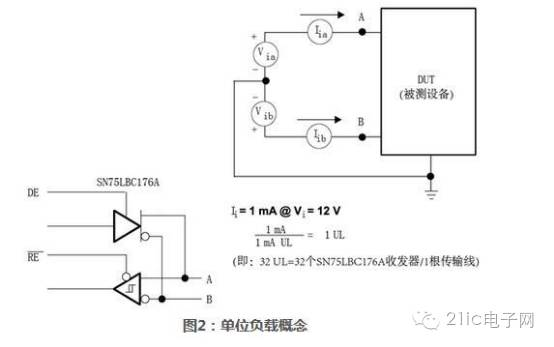
2.2 Signal Attenuation and Distortion
A useful rule of thumb is that under maximum signal rate (in Hz) communication conditions, signal attenuation of -6dB is allowed. Generally, cable suppliers provide signal attenuation charts. The curve in Figure 3 shows the relationship between 24-AWG cable attenuation and frequency.
The simplest way to determine the extent of random noise, jitter, distortion, etc., affecting the signal is to use an eye diagram. Figure 4 shows the signal distortion at the receiving end under different signal rates using 20AWG twisted pair cable at 500 meters. As the signal rate increases further, the effects of jitter become more pronounced. At 1Mbit/s, jitter is about 5%, and at 3.5Mbit/s, the signal begins to be completely overwhelmed, and transmission quality is severely degraded. In practical systems, the allowable maximum jitter is generally less than 5%.
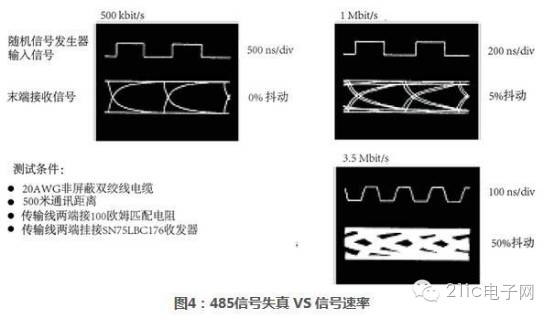
2.3 Failure Protection and Fault Tolerance
Like any other system design, it is essential to habitually consider failure response measures, whether these failures are naturally occurring or induced by the environment. For factory control systems, it is usually required to protect against extreme noise voltages. The differential transmission mechanism provided by 485, especially the wide common-mode voltage range, gives 485 a certain immunity to noise. However, in complex and harsh environments, its immunity may not be sufficient. There are several methods to provide protection, with the most effective being current isolation, which will be discussed later. Current isolation can provide better system-level protection, but it is also more expensive. A more popular and cheaper solution is to use diode protection. Using diode methods instead of current isolation is a compromise, providing protection at a lower level. External diodes and internally integrated transient protection diodes are shown in the following figure:
Figure 5 shows the SN75LBC176 485 transceiver with external diodes to prevent transient spikes.
RT is usually the termination resistor, equal to the cable characteristic impedance R0.
Figure 6 shows the SN75LBC184 485 transceiver with integrated transient suppression diodes, used when full 485 functionality is desired but PCB space is limited. The SN75LBC184 integrates protection diodes internally, specifically for high-energy electrical noise environments, and can directly replace the SN75LBC176.
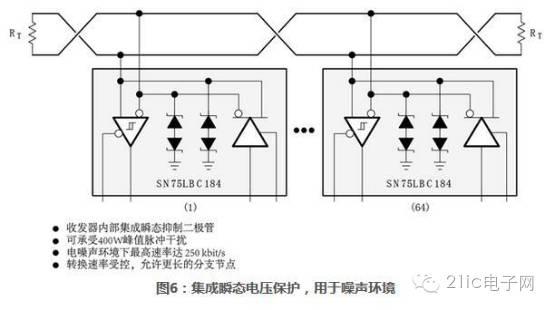
Many 485 applications also require failure protection, which is beneficial for the application layer and needs careful consideration and understanding.
In any interface system where multiple drivers/receivers share the same bus, drivers are mostly inactive, a state known as bus idle. When the driver is in idle state, the driver output is in high impedance. When the bus is idle, the line voltage is in a floating state (i.e., it is uncertain whether it is high or low). This may cause the receiver to be erroneously triggered to high or low (depending on environmental noise and the last level polarity before the line floated). Clearly, this situation is undesirable. Relevant circuits need to be in front of the receiver to turn this uncertain state into a known, predetermined level, known as failure protection. In addition, failure protection must also prevent data errors caused by short circuits.
There are many methods to achieve failure protection, including adding hardware circuits and using software protocols. Although implementing software protocols can be complex, it is the preferred method. However, since most system designers and hardware designers prefer to use hardware to achieve failure protection, adding hardware circuits is more commonly used.
Regardless of whether there is a short circuit or open circuit, the failure protection circuit must provide the receiver with a clear input voltage. If the environment of the communication line is very harsh, then line termination matching is also necessary.
Currently, many manufacturers have begun to integrate some failure protection circuits (such as open-circuit failure protection) into the chip. Typically, these additional circuits only add a high-value pull-up resistor at the receiver’s non-inverting input and a high-value pull-down resistor at the inverting input. These two resistors are usually around 100KΩ, and these resistors, along with the termination matching resistor, form a potential driver that can only provide a few mV of differential voltage. Therefore, this voltage (receiver critical voltage) is not sufficient to switch the receiver state. Using such internal pull-up and pull-down resistors allows the bus to not require termination matching, but will significantly reduce the maximum signal rate and reliability.
Figure 7 provides some common external failure protection circuits for 485 interfaces, each circuit strives to maintain the input voltage at the receiver not less than the minimum critical value and maintain a known logic state under one or more fault conditions (open circuit, idle, short circuit). In these circuits, R2 represents the transmission line impedance matching resistor and becomes part of the voltage driver: generating a steady-state bias voltage. Here it is assumed that each receiver represents one unit load.
The table on the right half of Figure 7 lists some typical resistor and capacitor values, the types of failure protection provided, the number of unit loads used, and signal distortion. In the next section, calculations will be provided on resistor values in short-circuit failure circuits to illustrate how to modify these resistor values to suit specific designs.
To achieve short-circuit protection, more resistors are needed. When the cable is short-circuited, the transmission line impedance becomes zero, and the termination matching resistor is also short-circuited. Adding extra resistors in series at the receiver’s input can achieve short-circuit failure protection.
Figure 8 shows that the additional resistor R3 can only be used in cases where the driver and receiver are separated. Most of the current 485 drivers and receivers are integrated into one chip (called a transceiver) and are internally connected to the same bus, making this transceiver unable to use short-circuit failure protection. If short-circuit protection is needed, transceivers with internal integrated short-circuit protection can be chosen, or separate driver and receiver devices like SN75ALS180 can be used. If short-circuit failure protection circuits are used in transceivers, resistor R3 will cause additional distortion in the output signal. Separate devices like SN75ALS180 will not have this issue because the driver is directly connected to the bus, bypassing R3.
Next, calculations on resistor values will be performed. If the transmission line is short-circuited, R2 is removed from the circuit, and the voltage at the receiver’s input is:
VID= VCC * 2R3 / (2R1 + 2R3)
For 485 applications, the standard specifies that receivers can recognize input signals as low as 200mV. Therefore, when VID> VIT or VID > 200mV, a known state can be determined. This is the first design constraint:
VCC* 2R3 / (2R1 + 2R3) > 200mV
When the transmission line is in a high-impedance state, the receiver is influenced by R1, R2, and R3, and its input voltage is:
VID= VCC* (R2 + 2R3) / (2R1 + R2 + 2R3)
This gives the second design constraint:
VCC * (R2 + 2R3) / (2R1 + R2 + 2R3) > 200mV
The transmission line will be influenced by the termination matching resistor R2 and twice the parallel of (R1+R3). The characteristic impedance Zo of the transmission line should match this, leading to the third design constraint:
Zo= 2R2 * (R1 + R3) / (2R1 + R2 +2R3)
Other design constraints include additional line load provided by the failure protection circuit, signal distortion caused by R3 and R1, and the receiver input resistance.
Note: SN75HVD10 and other 3.3V 485 transceivers and newer products integrate short-circuit/open-circuit failure protection circuits internally.
Computers and industrial serial interfaces are often in noisy environments that may affect the integrity of data transmission. For any interface circuit, a tested method to improve noise performance is current isolation.
In data communication systems, isolation means that there is no direct current flow between multiple drivers and receivers. Isolation transformers provide power to the system, while optical couplers or digital isolator devices provide data isolation. Current isolation can eliminate ground loop currents and suppress noise voltages. Therefore, using this technique can suppress common-mode noise and reduce other radiated noise.
For example, Figure 9 shows a node of a process control system, connecting a data logger and a main computer via a 485 link.
When a nearby motor starts, there is often a momentary difference in ground potential between the data logger and the computer, which usually causes a large current. If data communication does not adopt an isolation scheme, data may be lost, and in worse cases, damage to the computer may occur.
The schematic in Figure 9 is a node of a distributed monitoring, control, and management system, which is typically used in process control. Data is transmitted via a pair of twisted wires, and the ground wire uses a shielding layer. Such applications often require low power consumption, as many remote sub-stations use batteries or require backup batteries (the device must be able to run on backup batteries for some time after power failure). Additionally, low-power counting allows for the use of small isolation transformers. As shown in Figure 9, the transceiver uses SN65HVD10; of course, any TI 3.3V or 5V RS485 transceiver, 3.3-V TIA/EIA-644 LVDS, or 3.3-V TIA/EIA-899 M-LVDS transceiver can be used in this circuit.
The example shown in Figure 9 can be used with 3.3V or 5V, with power supplied through transformer isolation, and data signals isolated using digital isolators. Since 485 transceivers require isolated power, an adjustable LDO voltage regulator must be isolated. A non-inverting oscillator circuit can drive the isolation transformer to achieve this function. The output voltage of the transformer, after adjustment and filtering, is used for low-dropout linear voltage regulators. In high EMI environments, this method is commonly used to prevent other distant electronic systems’ noise from coupling into the main power supply. The TPS7101 is used to power other electronic components, providing up to 500mA of current. By adjusting the bias resistor R7, the TPS7101 can output 3.3V or 5V, specific resistor values are listed in the BOM.
Data signal isolation is completed by the three-channel digital isolator ISO7231M. This device can provide 150Mbps signal rates, 2.5KV (rms) voltage isolation, and 50KV/us instantaneous discharge protection.
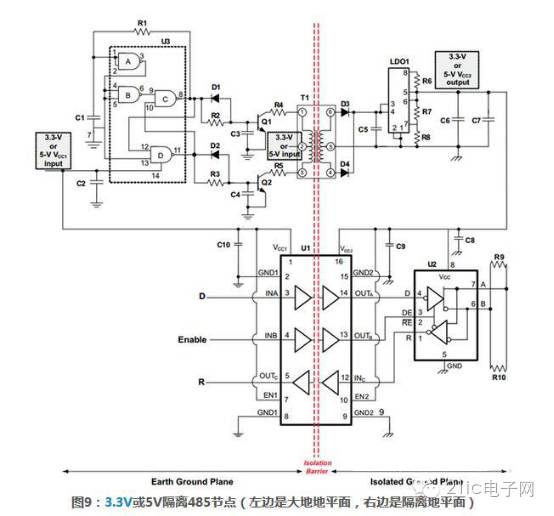
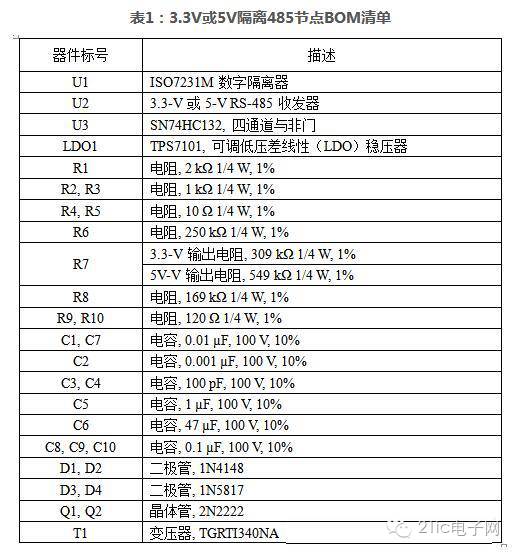
3. Example of Process Control Design
To gain more knowledge about 485 system design, a good approach is to look at specific examples. Consider a system with a capacity of 1 master controller and several sub-stations in a factory automation system, where each sub-station can send and receive data.
The system characteristics are as follows, with general specifications shown in Figure 10.
· The farthest sub-station is 500 meters from the master controller
· 31 sub-stations (32 devices including the master)
· Signal transmission rate is 500 kbit/s
· Half-duplex communication
Devices following the 485 standard transmit data at 500 kbit/s, requiring the driver output transition (rise/fall) time tt not to exceed 0.3 unit interval time (UI), so:
tt≤ 0.3 * (1 /(500 * 103) ) = 600ns
If the cable transmission signal speed equals the speed of light in a vacuum, the signal transmission delay tpd is 3.33ns/m, multiplied by the transmission line length of 500 meters, resulting in 1667ns.
According to section 2.1, the formula can determine whether the transmission line is a distributed parameter model or a lumped parameter model: if 2tpd ≥ tt/5, the transmission line is considered a distributed parameter model. Clearly, 3334 > 120, so the transmission line model in this example is a distributed parameter model. In industrial environments, this transmission line must be terminated properly.
Regarding attenuation, although the signal rate is 500 kbit/s, the fundamental frequency is 250 kHz; we still calculate attenuation based on 500 kHz because the signal actually contains higher frequency components. According to the empirical rule that maximum attenuation should not exceed -6dB, it is required that the maximum attenuation at the end of the 500-meter cable should be less than -6dB, i.e., 0.36dB/30 meters. We refer to the chart in Figure 3, which is provided by the cable manufacturer showing the relationship between attenuation and frequency; the attenuation corresponding to 500 kHz frequency is slightly above 0.5dB/30 meters, exceeding the design constraint of 0.14dB/30 meters. In this example, this is permissible, as slightly reducing the noise margin provided by conservative rules is acceptable.
This article is transferred from the network, copyright belongs to the original author. If you find it unsatisfactory, please contact us for deletion!
Advertisement
About Lichuang Mall
Lichuang Mall (WWW.SZLCSC.COM) was established in 2011, dedicated to providing customers with one-stop online procurement services for electronic components, with lightning delivery in 4 hours. It has over 10,000 square meters of modern component warehouse, with over 160,000 types of stock available. The group’s full electronic industry chain self-operated services cover: online EDA (LCEDA) + industry-leading PCB prototyping/small batch + component mall + stencil manufacturing + SMT placement + electronic design education and solutions. As a comprehensive electronic component vertical mall with a complete variety, self-operated inventory, and guaranteed quality, all components in Lichuang Mall are sourced from official channels of manufacturers or agents, ensuring original and genuine products, providing you with professional one-stop electronic component procurement services.

